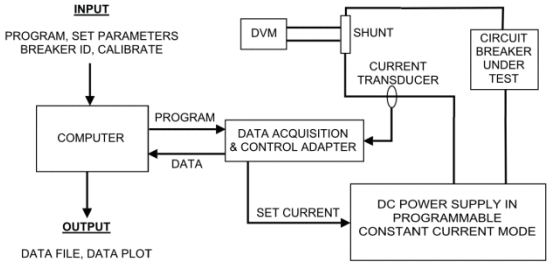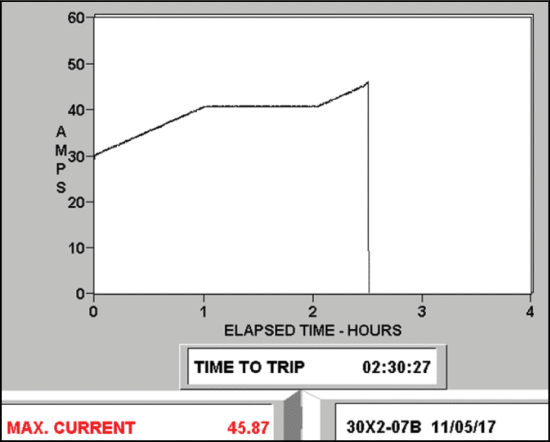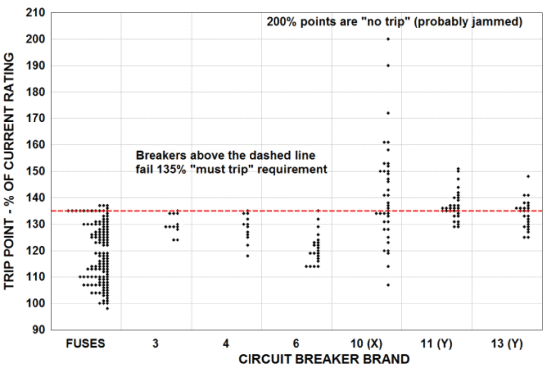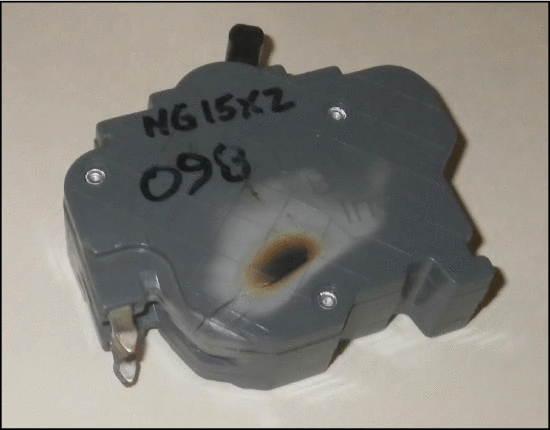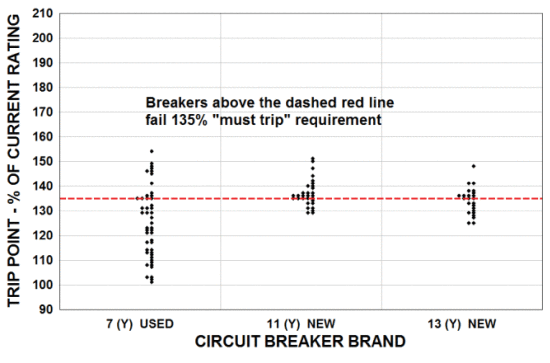mbrooke
Batteries Included
- Location
- United States
- Occupation
- Technician
Interesting IEEE article I came across, and its free.
https://ieeexplore.ieee.org/document/8283732
Testing shows that not only FPE have higher than normal failure rates, but also their clones which came after. Further, it is estimated FPE breakers are behind 2,800 fires, 116 injuries, 13 fatalities and $40 million in property damage just every year. Also while not safety related but still interesting some breakers from other manufacturers actually tripped under 100%.
I somewhat disagree with the recommendation that breakers should become solid state. But with AFCI and GFCI already mandated its inevitable.
........................................................................................................................................................................................................................................................................................
Abstract: Test results presented in this paper demonstrate that some brands of residential molded case circuit breakers do not operate properly within the limits specified by the applicable standard. The samples tested are both used, from homes, and new, purchased at retail sources. The minimum trip current is determined for each breaker. The test procedure encompasses the basic overload trip requirements of the applicable standard. Breakers that do not open the circuit at or below 135% of rated current fail to meet the requirements of the standard. Test results vary substantially from brand to brand. The best brands are essentially failure free. The failure rate of the worst-case brands is in the order of 50% for both used breakers from homes and new breakers recently purchased. Some samples, primarily multi-pole breakers, do not open the circuit at any level of applied current. Failure of a circuit breaker in a home to operate properly when required poses an increased risk of fire and injury.
Published in: IEEE Access ( Volume: 6 )
Page(s): 10062 - 10068
Date of Publication: 07 February 2018
Electronic ISSN: 2169-3536
INSPEC Accession Number: 17627890
DOI: 10.1109/ACCESS.2018.2803298
Publisher: IEEE

Test results are presented for residential circuit breakers. The test procedure encompasses the basic overload trip requirements of the applicable standard. The best bran... View more
Hide Full Abstract
SECTION I.
[h=2]Introduction[/h]
Circuit breaker panels were installed in most housing constructed in the USA from about 1960 onward. Panels with screw-in Edison base fuses were more common in earlier construction. Either type satisfies the overcurrent protection requirement of applicable building codes. They are fundamental safety devices that help prevent electrical fires. This paper reports test results for molded case circuit breakers used to supply 15A to 70A circuits in 120/240V AC residential applications. In this paper “breaker” and “circuit breaker” are used interchangeably.
Circuit breakers have advantages of convenience and safety. There is no need to stock and replace “blown” fuses. The use of circuit breakers eliminates two unsafe practices; substituting a higher-amperage fuse (“overamping”) to eliminate frequent outages in an overloaded circuit, and putting a penny in the socket behind a blown fuse to restore power if a spare fuse is not available.
The safety advantage of circuit breakers is negated if they do not operate properly. A breaker that trips (opens the circuit) only at higher current than it should for its rating presents the same hazard as overamping. A breaker that jams (does not trip at all - at any current) poses the same hazard as the penny behind the fuse.
Proper performance of residential circuit breakers is assured to a limited extent by our system of “listing” and “labeling”. A nationally recognized testing laboratory (NRTL) examines samples of a breaker type submitted by a manufacturer and puts it on a list of acceptable equipment if it meets the applicable requirements.
Subsequently, quarterly or less often, an inspector from the NRTL visits the manufacturer’s facility to check that the breakers being manufactured and shipped at that time are the same as described in the listing. The inspector also witnesses the manufacturer’s tests of some breakers taken from the production line.
As long as the listing is maintained, the NRTL permits the manufacturer to “label” each listed breaker that it ships. The labeling of a breaker with the NRTL’s logo is the manufacturer’s certification that the breaker conforms to the applicable standard, which is UL489 [1]. Distributors, installers, inspectors and the general public take the NRTL logo as assurance that each and every breaker so labeled will perform properly in the event of an electrical malfunction. Circuit breaker manufacturers contract with the NRTL for the listing service, for the follow-up inspection services and for the labels that are applied to the breakers. The manufacturers are clients of the NRTLs.
The listing and labeling system works properly provided that manufacturers consistently maintain a suitable level of quality control for breakers that are shipped. That is not rigorously audited by the NRTL or any other entity, however. There is no systematic random sample testing of breakers obtained from the normal supply chain. There is no test data available to specifiers, installers, public safety agencies or homeowners by which to judge the relative quality of the various brands that are already installed or available for new installations.
One particular circuit breaker brand did capture public attention due to poor quality [2]. The tests reported in this present paper were originally initiated to quantify the defect level of that particular brand and make the results available to persons involved in decisions as to their replacement. A method was subsequently developed to link circuit breaker defect statistics to electrical fire statistics so as to quantify the resulting injuries and losses attributable to the substandard performance of that particular brand [3]. “Brand X”, as it is identified in [3], is estimated in that paper to be a causative factor in about 2,800 fires in the USA every year, resulting in an estimated 116 injuries, 13 fatalities and $40 million in property damage. Those are fires that would not occur if the Brand X breakers performed correctly.
From time to time there have been recall notices for some defective production lots of various circuit breaker brands and for breakers with counterfeit labels [4], [5]. These notices typically include a statement to the effect that, “if the breakers do not operate correctly there is an increased risk of fire and injury.” This reflects general agreement that substandard breaker performance poses an increased electrical fire hazard.
Brand X was assumed to be a unique outlier when [3] was published. Subsequent testing of a variety of brands of circuit breakers from homes has shown that assumption to be false. There are several brands with a high defect level that have been installed in homes over the years.
The most recent tests in this study have been of new breakers purchased from retail sources. Three of the available brands demonstrate substandard performance. This indicates that the present listing, labeling and independent quality auditing protocols for this type of product fall short of the goal of assuring the required level of electrical fire safety.
SECTION II.
https://ieeexplore.ieee.org/document/8283732
Testing shows that not only FPE have higher than normal failure rates, but also their clones which came after. Further, it is estimated FPE breakers are behind 2,800 fires, 116 injuries, 13 fatalities and $40 million in property damage just every year. Also while not safety related but still interesting some breakers from other manufacturers actually tripped under 100%.
I somewhat disagree with the recommendation that breakers should become solid state. But with AFCI and GFCI already mandated its inevitable.
........................................................................................................................................................................................................................................................................................
Abstract: Test results presented in this paper demonstrate that some brands of residential molded case circuit breakers do not operate properly within the limits specified by the applicable standard. The samples tested are both used, from homes, and new, purchased at retail sources. The minimum trip current is determined for each breaker. The test procedure encompasses the basic overload trip requirements of the applicable standard. Breakers that do not open the circuit at or below 135% of rated current fail to meet the requirements of the standard. Test results vary substantially from brand to brand. The best brands are essentially failure free. The failure rate of the worst-case brands is in the order of 50% for both used breakers from homes and new breakers recently purchased. Some samples, primarily multi-pole breakers, do not open the circuit at any level of applied current. Failure of a circuit breaker in a home to operate properly when required poses an increased risk of fire and injury.
Published in: IEEE Access ( Volume: 6 )
Page(s): 10062 - 10068
Date of Publication: 07 February 2018
Electronic ISSN: 2169-3536
INSPEC Accession Number: 17627890
DOI: 10.1109/ACCESS.2018.2803298
Publisher: IEEE

Test results are presented for residential circuit breakers. The test procedure encompasses the basic overload trip requirements of the applicable standard. The best bran... View more
Hide Full Abstract
SECTION I.
[h=2]Introduction[/h]
Circuit breaker panels were installed in most housing constructed in the USA from about 1960 onward. Panels with screw-in Edison base fuses were more common in earlier construction. Either type satisfies the overcurrent protection requirement of applicable building codes. They are fundamental safety devices that help prevent electrical fires. This paper reports test results for molded case circuit breakers used to supply 15A to 70A circuits in 120/240V AC residential applications. In this paper “breaker” and “circuit breaker” are used interchangeably.
Circuit breakers have advantages of convenience and safety. There is no need to stock and replace “blown” fuses. The use of circuit breakers eliminates two unsafe practices; substituting a higher-amperage fuse (“overamping”) to eliminate frequent outages in an overloaded circuit, and putting a penny in the socket behind a blown fuse to restore power if a spare fuse is not available.
The safety advantage of circuit breakers is negated if they do not operate properly. A breaker that trips (opens the circuit) only at higher current than it should for its rating presents the same hazard as overamping. A breaker that jams (does not trip at all - at any current) poses the same hazard as the penny behind the fuse.
Proper performance of residential circuit breakers is assured to a limited extent by our system of “listing” and “labeling”. A nationally recognized testing laboratory (NRTL) examines samples of a breaker type submitted by a manufacturer and puts it on a list of acceptable equipment if it meets the applicable requirements.
Subsequently, quarterly or less often, an inspector from the NRTL visits the manufacturer’s facility to check that the breakers being manufactured and shipped at that time are the same as described in the listing. The inspector also witnesses the manufacturer’s tests of some breakers taken from the production line.
As long as the listing is maintained, the NRTL permits the manufacturer to “label” each listed breaker that it ships. The labeling of a breaker with the NRTL’s logo is the manufacturer’s certification that the breaker conforms to the applicable standard, which is UL489 [1]. Distributors, installers, inspectors and the general public take the NRTL logo as assurance that each and every breaker so labeled will perform properly in the event of an electrical malfunction. Circuit breaker manufacturers contract with the NRTL for the listing service, for the follow-up inspection services and for the labels that are applied to the breakers. The manufacturers are clients of the NRTLs.
The listing and labeling system works properly provided that manufacturers consistently maintain a suitable level of quality control for breakers that are shipped. That is not rigorously audited by the NRTL or any other entity, however. There is no systematic random sample testing of breakers obtained from the normal supply chain. There is no test data available to specifiers, installers, public safety agencies or homeowners by which to judge the relative quality of the various brands that are already installed or available for new installations.
One particular circuit breaker brand did capture public attention due to poor quality [2]. The tests reported in this present paper were originally initiated to quantify the defect level of that particular brand and make the results available to persons involved in decisions as to their replacement. A method was subsequently developed to link circuit breaker defect statistics to electrical fire statistics so as to quantify the resulting injuries and losses attributable to the substandard performance of that particular brand [3]. “Brand X”, as it is identified in [3], is estimated in that paper to be a causative factor in about 2,800 fires in the USA every year, resulting in an estimated 116 injuries, 13 fatalities and $40 million in property damage. Those are fires that would not occur if the Brand X breakers performed correctly.
From time to time there have been recall notices for some defective production lots of various circuit breaker brands and for breakers with counterfeit labels [4], [5]. These notices typically include a statement to the effect that, “if the breakers do not operate correctly there is an increased risk of fire and injury.” This reflects general agreement that substandard breaker performance poses an increased electrical fire hazard.
Brand X was assumed to be a unique outlier when [3] was published. Subsequent testing of a variety of brands of circuit breakers from homes has shown that assumption to be false. There are several brands with a high defect level that have been installed in homes over the years.
The most recent tests in this study have been of new breakers purchased from retail sources. Three of the available brands demonstrate substandard performance. This indicates that the present listing, labeling and independent quality auditing protocols for this type of product fall short of the goal of assuring the required level of electrical fire safety.
SECTION II.




